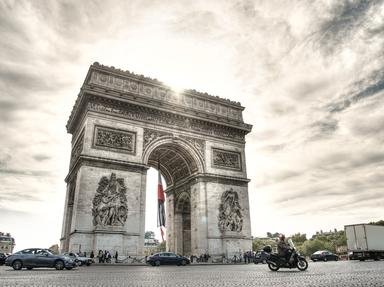Quiz Answer Key and Fun Facts
1. The cathedral of Notre-Dame was begun in 1163 under the auspices of which bishop?
2. The Palais du Luxembourg, whose construction was begun in 1615, was built for which queen, the second wife of Henri IV?
3. This cafe is Paris's oldest, and can boast among its former patrons Benjamin Franklin, Voltaire, Rousseau, and the young Napoleon Bonaparte. What is its name?
4. When were the Catacombs de Paris established?
5. On 14 July 1790, the Fete de la Federation celebrated the first anniversary of the storming of the Bastille with ceremonies and processions. Where was the Fete held?
6. In October 1789, the royal family were brought back to Paris following a march to the palace at Versailles, led by Parisian women. Where were the royal family held following their return?
7. It is, for many, the enduring symbol of the French Revolution. But where was the guillotine located for most of its grisly work during the Revolution?
8. Originally built as a residence for a palace official, this building is perhaps now best known as the ante-chamber to the guillotine during the Revolution. What is it called?
9. On 9 Thermidor 1794, a coup overthrew the Jacobin dictatorship and effectively ended the Reign of Terror. Where did the Jacobin leader, Robespierre, and his remaining followers flee to before being captured?
10. During his reign as Emperor (1804-1814), Napoleon I was very fond of erecting monuments to the glory of himself and his army across Paris, even if many of those he planned were never built. But which of these famous Parisian monuments was not built by him?
11. The remains of Napoleon I returned to Paris in 1840, but were not interred in the crypt specially designed for them until 1861. Where is the imperial tomb located?
12. Under Napoleon III (1852-1870), the city was transformed through a massive programme of modernization and urban renewal. What is the name of the Prefect of the Seine who was responsible for the grand transformation?
13. One of the many periods of unrest in Paris during the nineteenth century, the Paris Commune lasted from 18th March to 28th May 1871. Where did the Commune begin?
14. Today it dominates the Champ-de-Mars and is seen by many as the symbol of the city, but when was the Eiffel Tower built?
15. Now one of the world's best art museums, the Musee d'Orsay was originally a railway station. To what other French city did the trains leaving the Gare d'Orsay travel?
Source: Author
belleepoque
This quiz was reviewed by FunTrivia editor
Beatka before going online.
Any errors found in FunTrivia content are routinely corrected through our feedback system.
